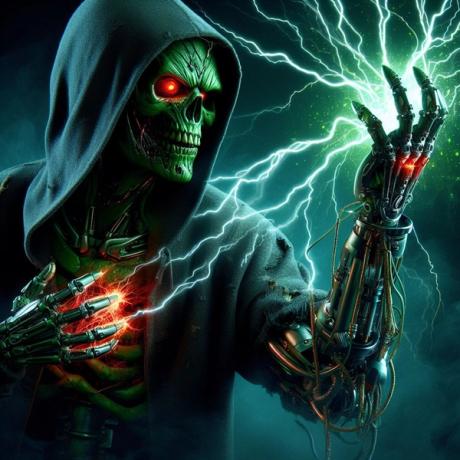
On 30 May 2024, The Art Newspaper published an article by Chris Michaels entitled “The art world’s AI dilemma: how can artists and museums thrive when big tech controls the monetising of artificial intelligence?” The article mentions the anxiety around artificial intelligence (AI). This is real. But, as an artist who has spent the last few years researching AI, incorporating it into my practice and observing its impact on the art market, I can see that this anxiety about AI generally—and the article’s focus on concerns about access to its most advanced forms—can be blown out of proportion when it comes to appreciating artists’ existing and future real-time engagement with these breakout tools.
To make a reductive analogy, presenting Big Tech’s monetisation of AI as a hindrance to artists and art institutions critically engaging with the technology is like saying photographers can’t make money from advancements in camera technology as long as Zeiss has a monopoly on lens production. Not only are tech companies’, artists’ and museums’ uses of AI not mutually exclusive, but artists have not traditionally had a stake in the monetisation of artistic materials. They–we–are consumers whose output is then valued by an unregulated and extremely competitive market.
AI’s summarising effect may indeed harm our understanding of art in museums by chipping away at contexts, as the article claims, when it is acting as a filter to the museum’s own archive—the lifeblood of any arts institution—rather than its existing published content. But neither AI nor its summaries pose an existential threat to the museum ecosystem per se. Considering the summarising impact of photographs, slideshows, documentaries, YouTube videos, social media content and virtual reality experiences—virtually all of which offer a reductive version of the museum’s information and exist outside of the museum’s editorial purview—it is safe to say that technology and media have thus far deepened the museum experience for millions of people.
“Access to, and control of, the technologies of production is a critical part of artistic, democratic and institutional freedom,” Michaels writes. This argument seems divorced from the realities faced by many artists. Consider that, in 2024, any full-frame camera kit worth its salt will set an artist back $5,000 to $25,000, a Macbook Pro capable of rendering animation or video will often cost $3,000 to $6,000, and peripheral devices necessary for production—from tablets to sound gear to lighting equipment—quickly add up to thousands of dollars. Adobe charges a monthly subscription fee starting at $22.99 for Photoshop alone. For painters, a single tube of high-quality oil paint can cost several hundred dollars, and while canvas costs are reasonably low, framing and transportation costs can quickly reach four-figure sums. Traditional artistic practices that involve digital or manual labour are often punishingly expensive and not exactly accessible. Why are we holding AI tools to higher standards than those we have held the entire art production ecosystem to for decades?
Artists already have consumer-level access to bleeding-edge AI
The article cites an imbalance of access to technology, suggesting artists may never get to participate in this new frontier of visual creation because the public has not been given access to the most advanced forms of AI. The notion that AI is gatekept is a hollow myth. To build on the argument made by Serpentine Future Art EcoSystems in the article, questioning whether highly advanced “frontier” AI models are even relevant to artists, consider recent comments by OpenAI’s chief technology officer Mira Murati stating that the models the company is working on in its labs are not too far ahead of the free, publicly accessible models. This relatively unprecedented type of recency and access, she argued, “brings people along”.
Meanwhile, artists have access to AI tools on the bleeding edge of consumer models—such as Midjourney’s photorealistic renderings based on prompts—which anyone can use. Upgrades to its system are launched regularly and new versions are accessible free of charge. Granted, Midjourney has many issues, including an inferior user interface and cultural biases, but a membership for unlimited renderings costs $30 per month. The company delegates the computing labour to its own servers so users can access it on nearly any device regardless of technical capacities. Compared to the traditional art-making ecosystem, companies like Midjourney lower the barrier to entry for artists by thousands of dollars.
A real challenge for artists is that Midjourney charges a minimum of $60 per month if the creator wishes to generate images in private. More affordable subscription plans place users’ output into the main chat-stream of generations, so others can “remix” their works or read their word prompts and use them for their own work later. For artists, that means paying at least $720 a year to use the software while preventing others from being privy to their creative practices. Even so, in many respects this tool is still a more affordable production process than being a painter or photographer.
Much of the debate (and litigation) about art and AI reflects a notion that the data AI is trained on should be sourced ethically. But the longstanding problem of social media companies data-mining their users remains unaddressed and ignored by many who want to hold the AI industry to account. With this selective hand-wringing over data privacy, conversations about AI and art have become mired in arguments about existing technologies and social platforms. These disputes distract from the enormous potential of a powerful tool. For the first time in human civilisation, every person with access to a web browser has been given the power to create images with incredible range and clarity, regardless of financial status, bodily capacity or technical skill.
I think we need to be always asking better questions about AI and art, rather than presuming that one will harm the other. AI is not the enemy any more than the internet was, or computers and cameras before them.


